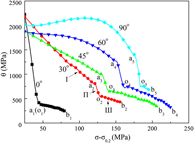Crossref Citations
This article has been cited by the following publications. This list is generated based on data provided by
Crossref.
Yang, Qingshan
Jiang, Bin
Li, Xin
Dong, Hanwu
Liu, Wenjun
and
Pan, Fusheng
2014.
Microstructure and mechanical behavior of the Mg–Mn–Ce magnesium alloy sheets.
Journal of Magnesium and Alloys,
Vol. 2,
Issue. 1,
p.
8.
Yang, Qingshan
Jiang, Bin
He, Junjie
Song, Bo
Liu, WenJun
Dong, Hanwu
and
Pan, Fusheng
2014.
Tailoring texture and refining grain of magnesium alloy by differential speed extrusion process.
Materials Science and Engineering: A,
Vol. 612,
Issue. ,
p.
187.
2014.
Extrusion.
Journal of the Japan Society for Technology of Plasticity,
Vol. 55,
Issue. 643,
p.
726.
He, Junjie
Jiang, Bin
Yang, Qingshan
Li, Xin
Xia, Xiangsheng
and
Pan, Fusheng
2015.
Influence of pre-hardening on microstructure evolution and mechanical behavior of AZ31 magnesium alloy sheet.
Journal of Alloys and Compounds,
Vol. 621,
Issue. ,
p.
301.
Berge, F.
Krüger, L.
Ullmann, M.
Krbetschek, C.
and
Kawalla, R.
2015.
Anisotropy of the Mechanical Properties of Twin-roll Cast, Rolled and Heat-treated AZ31 as a Function of Temperature and Strain rate.
Materials Today: Proceedings,
Vol. 2,
Issue. ,
p.
S233.
Yang, Qing Shan
Jiang, Bin
He, Jun Jie
Gao, Zheng Yuan
Dai, Jia Hong
and
Pan, Fu Sheng
2015.
Microstructure and Mechanical Responses of Extruded Magnesium Alloy Sheets with Lithium Addition.
Materials Science Forum,
Vol. 816,
Issue. ,
p.
504.
Yang, Qingshan
Jiang, Bin
Li, Jun
Dong, Hanwu
Liu, Wenjun
Luo, Suqin
and
Pan, Fusheng
2016.
Modified texture and room temperature formability of magnesium alloy sheet by Li addition.
International Journal of Material Forming,
Vol. 9,
Issue. 3,
p.
305.
Qingshan, Yang
Bin, Jiang
Qing, Xiang
Suqin, Luo
Xiaowen, Yu
and
Fusheng, Pan
2016.
Microstructure Evolution and Corrosion Performance of AZ31 Magnesium Alloy Sheets.
Rare Metal Materials and Engineering,
Vol. 45,
Issue. 7,
p.
1674.
Yang, Qing Shan
Liu, Wen Jun
and
Yu, Zu Jian
2017.
Microstructure Evolution and Mechanical Properties of Extruded Mg-Al-Zn-Sn Alloy Sheets.
Materials Science Forum,
Vol. 898,
Issue. ,
p.
300.
He, Junjie
Mao, Yong
Gao, Yuping
Xiong, Kai
Jiang, Bin
and
Pan, Fusheng
2019.
Effect of rolling paths and pass reductions on the microstructure and texture evolutions of AZ31 sheet with an initial asymmetrical texture distribution.
Journal of Alloys and Compounds,
Vol. 786,
Issue. ,
p.
394.
Yang, Qingshan
Dai, Qingwei
Lou, Chao
Dai, Jiahong
Zhang, Jianyue
Jiang, Bin
and
Pan, Fusheng
2019.
Twinning, grain orientation, and texture variations in Mg alloy processed by pre-rolling.
Progress in Natural Science: Materials International,
Vol. 29,
Issue. 2,
p.
231.
Yang, Qingshan
Jiang, Bin
Wang, Lifei
Dai, Jiahong
Zhang, Jianyue
and
Pan, Fusheng
2020.
Enhanced formability of a magnesium alloy sheet via in-plane pre-strain paths.
Journal of Alloys and Compounds,
Vol. 814,
Issue. ,
p.
152278.
Pan, Fusheng
Jiang, Bin
Wang, Jingfeng
Hu, Yaobo
and
Luo, Suqin
2022.
High Plasticity Magnesium Alloys.
p.
1.



